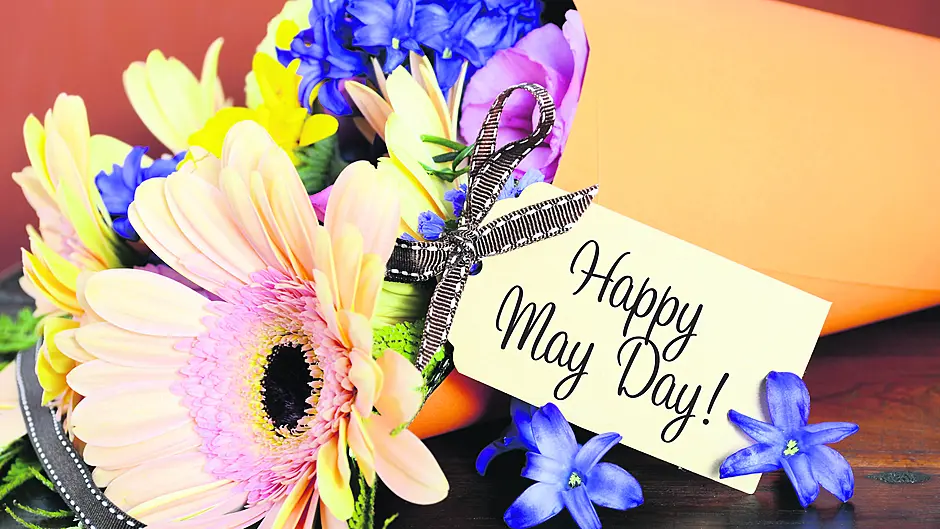This week we welcome a new month. But not just any month. Decorating wells, bathing in morning dew, stinging nettles and May Day cabbages galore – such were the past symbols of Bealtaine’s arrival
BY ROBERT HUME
NOWADAYS known as Labour Day, and celebrated with a public holiday, the pagan festival of Bealtaine (Day of Fire) has its roots in ancient Greece and Rome.
Bealtaine marked the beginning of summer and the opening of the agricultural season in Ireland.
Cattle and sheep were moved outdoors, twice-yearly rent was paid and labourers were hired at fairs, explains Cork local studies librarian Kieran Wyse.
It was a joyous occasion, with an abundance of flowers. Yellow marigolds, buttercups and primroses, not only decorated dressing tables and May altars in homes and churches, but were also attached to cows’ tails and milk churns. Streamers, ribbons and egg shells left over from Easter were tied to ‘May’ and hawthorn bushes. Bunches of flaggers (leaves) were strewn on doorsteps and windowsills throughout West Cork, while Cape Clear fishermen put them in their boats for good luck.
Families sang and danced around maypoles and bonfires, watched May Day processions and May Queen competitions. Some ate a special oatcake with grilled salmon and nettle sauce.
But there was a darker side. People were cautious on this day, and the sight of strangers bore a risk. Folk living in Roaringwater Bay refused to give anything to anyone at Bealtaine – no tea, sugar, not even the time of day!
Some worried that fairies would tamper with landmarks to confuse people, that a cuckoo call denoted very bad luck, while any animal sickness was a curse, and therefore incurable.
Hares and hedgehogs drew terror, as superstition held they were malign old women, who had changed themselves into animals to steal milk and butter.
Locally, Bealtaine was associated with a huge range of traditions.
Courtmacsherry women were known for bathing their faces in the morning dew. They collected it in dishes, or on clear linen cloths.
‘The plainest girl will be beautiful if she rises early on May Day and bathes her face in morning dew at sunrise,’ notes historian Bridget Haggerty. ‘If she was daring enough to undress and roll naked, she was given great beauty … the dew was also believed to bring immunity to freckles, sunburn, chapping, and wrinkles during the coming year.’
Well water was also hugely significant. Locals from Ballyvourney would walk over the mountain to a shrine in Kerry, where they prayed and collected holy water, thought to benefit farm animals.
In Cape Clear the first person to drink water from the top of a well would stay healthy all year.
 ‘Summer on the door’ was a tradition the Minihane family would observe every May day. (Photo: Ane Minihane)
‘Summer on the door’ was a tradition the Minihane family would observe every May day. (Photo: Ane Minihane)
Decorating the house for good luck was a common practice in Clonakilty. One lady told The Southern Star in 1982 that she ‘couldn’t let the day pass’ without scattering May tree leaves in every room.
A long-held tradition in Castletownbere once saw hundreds of May Day cabbages go on sale in the town square.
Locals can still remember some of these customs.
‘Hanging a green leafy item on the front door was usually done in the morning to mark the first day of summer,’ says John Leonard from Cork city. This is still being done in Skibbereen by the Minihane family on Bridge Street.
John recalls that when he was a pupil at Lisheen School, some classmates would whack one another with stinging nettles!
Brendan McCarthy from Skibbereen also recalls hanging a green branch on the hall door at Bealtaine during the 1950s and 1960s.
On May Eve, daffodils and furze were placed all over the house, he said. ‘Seemingly, the fairies hated the colour yellow!’
On May Day morning, bonfires were lit ‘to dispel evil spirits.’
Some of the religious practices associated with Bealtaine continue to be observed today. In Coláiste Choilm school in Ballincollig, pupils construct May altars in their classrooms. An open air mass is still held on May eve near Lough Hyne, where crowds of people pray and ‘make the rounds’ at Sceabar Well.
Every time a person goes around the well, they drop a white pebble in, while old rags are tied onto a whitethorn bush growing along its side.
However, many old superstitions surrounding Bealtaine have almost gone.
In recent years, the occasion has been marked by events designed to suit modern tastes, like funfair rides in Dunmanway; a vintage car, motorbike festival and street carnival in Kinsale. Passage West and Monkstown have staged a treasure hunt, a fancy dress competition, even a picnic for soft, cuddly toys: Teddy’s Bealtaine has arrived!







